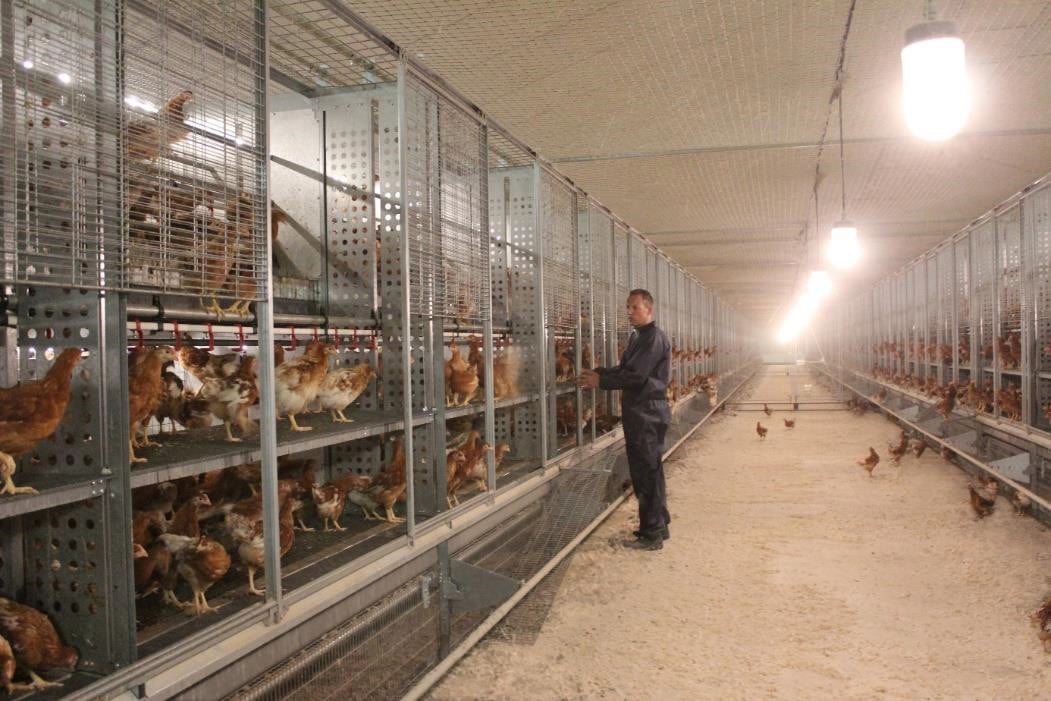Differences between cage and aviary systems
Cage systems usually focus only on egg production and not on the chicken’s needs. You might wonder whether it is important to keep the needs of a chicken in mind? We at Vencomatic Group think it is important for several reasons. First of all, we think that when a bird feels well, the performance will be better. But besides that, we want to treat the birds with respect. Our goal is to develop animal friendly poultry systems, while preserving the planet. To achieve this goal, we guide customers in the transformation from cage to aviary systems. Vencomatic Group has over 40 years of experience in the change from cage to aviary.
This is chapter 2 of our 'Cage Free' booklet
A major difference between cage and aviary systems is who decides the management of subjects like egg collection, moment of light and darkness, feeding times, etc. For cage systems, the farmer determines the management of the birds, but in aviary systems the birds determine the management. This might sound daunting, but there is no reason to panic. Hens have laid their eggs in nests for many years, so they know by nature what to do. Furthermore, we have developed some management tools for farmers to help guide the hens in the correct direction. To achieve good results with an aviary system a few aspects are important:
1. Rearing
2. Lay-out of the house
3. Management of the birds
In this article, we focus on the first point and explain what is needed during rearing to prepare the birds for the production period. In practice we often see that a company first invests in an aviary system without changing the rearing system, because they underestimate the impact of the rearing. Good rearing is actually essential for good results in the aviary house. Most companies realize this after one flock and then invest in the rearing. The behavior and physical condition of a hen needs to be different in an aviary than in a cage and the right rearing can prepare the hen for this.
In terms of behavior, hens in a cage only sit and walk, but hens in aviaries need to jump, fly or perch. These behaviors can be taught in the rearing phase. Also, hens in cages can lay their egg anywhere and the eggs will roll automatically on the egg belt, while hens in aviaries need to learn to lay the eggs in the nest. Moreover, the bone and muscle development is much more important in aviary systems than in cages.
Natural behavior of chickens
It might sound difficult to teach the hens how to jump, fly, perch or lay their eggs in a nest. However, these are all natural behaviors for chickens as we can see in the ancestor of the domestic hen, the red jungle fowl (Figure 1). The red jungle fowl (Gallus gallus) comes originally from South East Asia and lives in small family groups in secondary forests, that consist of grassland with some shrubs and trees (Collias and Saichuae, 1967). The red jungle fowl eats seeds, fruits and insects, which is why our current hens are omnivores too. To get this varied diet, they have a sharp, strong and slightly curved beak and sharp nails for scratching on the ground. The majority of the time is spent on the forest floor, but the red jungle fowl flies into trees to sleep perched on branches. Red jungle fowl lay their eggs in an indentation on the ground that is surrounded by tall grass or bushes (Collias and Collias, 1967).
It is clear that the behaviors we expect our current hen to perform in an aviary system are very similar to the natural behavior of the red jungle fowl. The basic behaviors and instincts have not changed much during the domestication process (Jensen, 2006). So if we do not disturb or force our hens, they will still jump or fly to higher locations to sleep on perches and lay eggs in a nest. We should empower these natural instincts of the hens in our management, instead of trying to control or limit the hens.
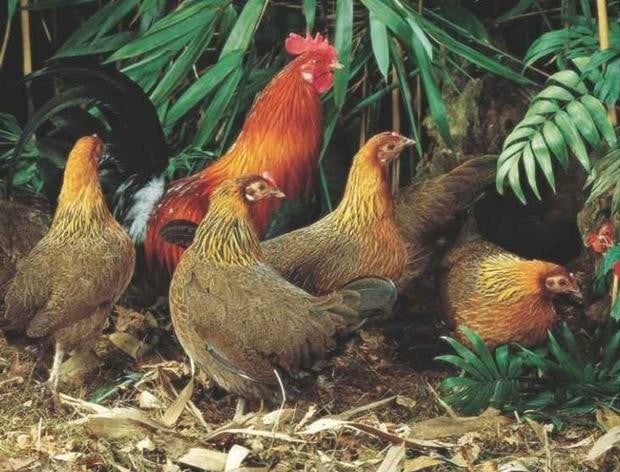 Figure 1. A typical red jungle fowl family, one rooster with a few females, in their natural habitat.
Figure 1. A typical red jungle fowl family, one rooster with a few females, in their natural habitat.
To show the importance of being able to perform these behaviors to our domestic hens, researchers make chickens work for access to nests or perches. Laying hens have been taught to work to gain access to a resource, by pecking at a key, pushing against a weighted door or by passing through a narrowing tunnel to see how important the resource on the other side is (Duncan, 1991). When the number of pecks required to gain access or the weight of the door is increased, the hens will continue to do the required task until the reward is not worth the work.
Using these techniques, laying hens are willing to work for access to a nest by passing through tunnels as narrow as 14 cm (Cooper and Appleby, 1996) and pushing against a door with more than 10 N resistance (Kruschwitz et al., 2008) to access a nest. Similar results are found for access to perches at night, where hens were willing to push against heavier doors to get access to a perch than doors that gave access to a perch that was blocked so perching was impossible (Olsson and Keeling, 2002).
Avoiding early-life stress
The first goal in rearing is to ensure the chicks start their life with as minimal stress as possible. The most sensitive period for stress is early-life and old age, because the brain undergoes major changes during these periods (Lupien et al., 2009). Stress at an earlier age can have long lasting effects on physiology, behaviour and cognition. When chicks experience heat stress during the first weeks of age, it affects their immune responses at later ages (Mashaly et al., 2004). Furthermore, stress at the age of 8 weeks resulted in a higher fearfulness at 27 weeks of age (Ericsson et al., 2016). Laying hens have also been found to be more dominant when reared under stressful conditions, possibly causing more aggression and pecking behavior during the laying period (Elfwing et al., 2015). It is apparent from these studies that stress during the rearing period of chicks must be minimized, to avoid problems during the laying period.
Therefore, it is important to give one day old chicks a safe environment on arrival. This means a comfortable temperature, feed and fresh water available and a place to sleep. Be careful for high temperature differences. In case the outside temperature is low, make the transition from the truck into the house as fast as possible. Release the birds near water and feed and keep an eye on the desired pressure for all drinking lines. Low pressure causes dehydration of the birds, but too high pressures leads to spilling of water. Follow the light program as advised by the genetic company for optimal physiological and behavioral development. When the birds are comfortable and settled, the training program starts.
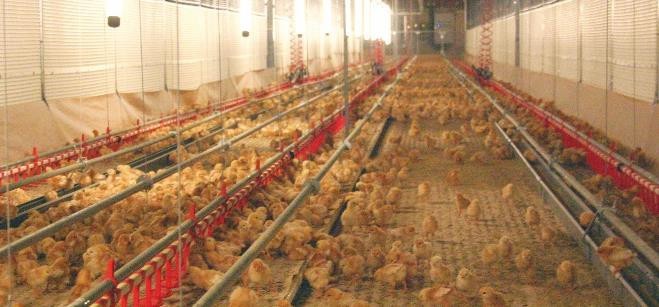
Figure 2. Easy access to water, feed and resting areas is crucial for good chick development.
Learning spatial skills
Animals learn the most and most easily during childhood, which is the rearing phase for chickens. During the first 8 weeks, the synapses in the brain (connections between neural cells) of chicks are maturing and this makes the chicks more susceptible for learning (Rogers, 1995). By rearing chicks in environment with vertical space, the use of elevated perches or platforms is increased at a later age (Brantsæter et al., 2016). When chicks are reared without elevated structures, they have problems getting on raised platform at later ages, which could be due to impaired spatial skills or to underdeveloped muscles and bones (Gunnarsson et al., 2000). Aviary-reared chicks have stronger bones and better developed breast and wing muscles at 16 weeks of age compared to chicks reared in cages (Casey-Trott et al., 2017a). These beneficial effects last for the entire laying period, the bones of aviary-reared hens are stronger than cage-reared hens at 73 weeks of age (Casey-Trott et al., 2017b). Another long term benefit is that aviary-reared hens suffer less collisions in the laying period, reducing the number of keel bone fractions (Pullin et al., 2020).
To turn this knowledge into practice, we have developed two types of rearing systems to train the chicks with elevated platforms (Figure 3 and 4). Which type you choose has to do with house lay-out and personal preference, but the outcome must be the same. Start with the winchable platform, feed and water on the lowest level, so birds can find it easily. After one week you start with raising one of the platforms a bit. Always make sure that the feed and drinking line are on the correct level. As the chickens are growing, also the lines need to be on a higher level every week. Check the drinking and eating behaviour of the birds. Give birds step by step more space, as well as in the height of the system but also on the floor. Birds can develop their jumping and perching skills together with their muscle and skeletal development. In this way you develop in a controlled and stress less environment healthy and strong birds, which know how you use the space, how to perch and how to find feed and water on different levels.
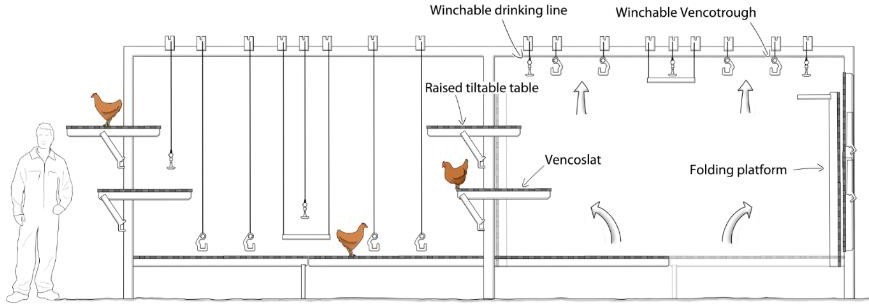
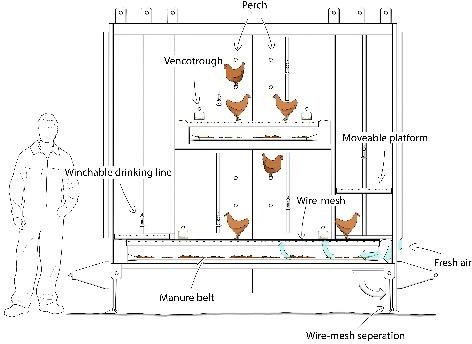 Figure 3. Rearing systems of Vencomatic Group, to teach the chicks spatial skills and increase muscle and skeletal development.
Figure 3. Rearing systems of Vencomatic Group, to teach the chicks spatial skills and increase muscle and skeletal development.
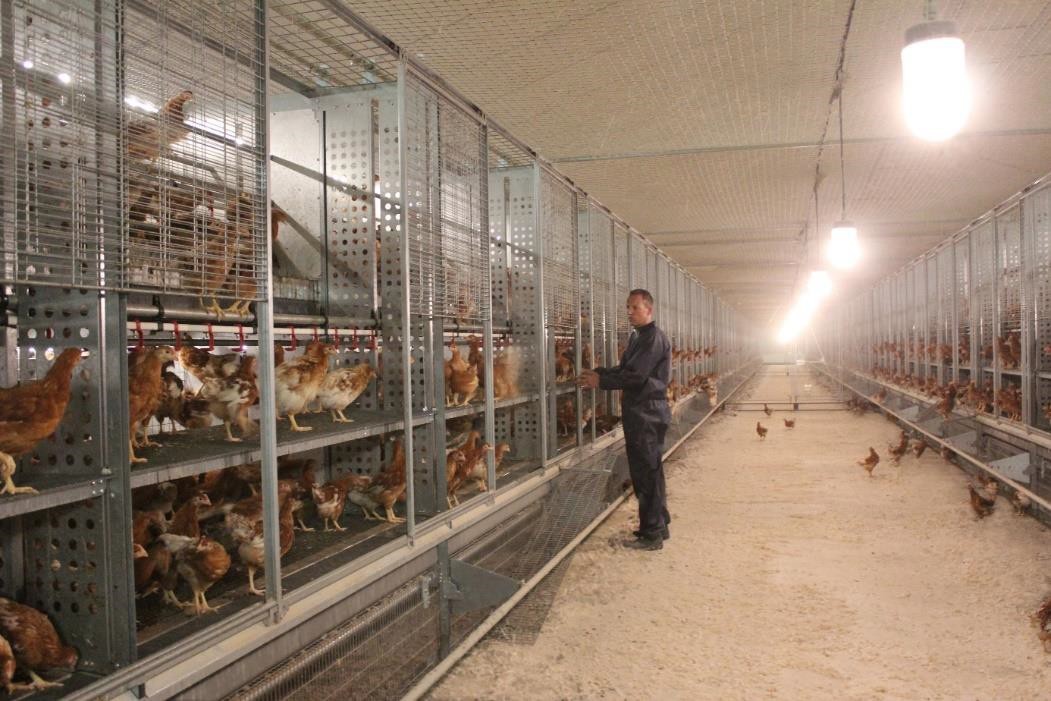 Figure 4. A photo of a rearing system in use, the chickens have learned to use the perches and move vertically through the system.
Figure 4. A photo of a rearing system in use, the chickens have learned to use the perches and move vertically through the system.
With thanks to Anne v.d. Oever for editing












.png?width=160&height=132&name=Egg%20packers%20-%20Vencomatic%20Group%20(2).png)
.png?width=160&height=132&name=Meggsius%20Select%20-%20Vencomatic%20Group%20(2).png)







